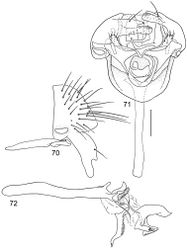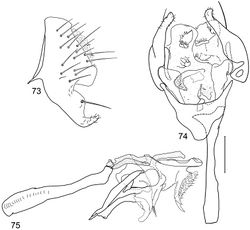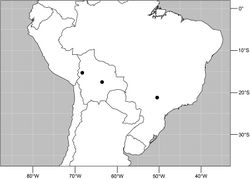Planinasus atrifrons
| Notice: | This page is derived from the original publication listed below, whose author(s) should always be credited. Further contributors may edit and improve the content of this page and, consequently, need to be credited as well (see page history). Any assessment of factual correctness requires a careful review of the original article as well as of subsequent contributions.
If you are uncertain whether your planned contribution is correct or not, we suggest that you use the associated discussion page instead of editing the page directly. This page should be cited as follows (rationale):
Citation formats to copy and paste
BibTeX: @article{Mathis2012ZooKeys225, RIS/ Endnote: TY - JOUR Wikipedia/ Citizendium: <ref name="Mathis2012ZooKeys225">{{Citation See also the citation download page at the journal. |
Ordo: Diptera
Familia: Periscelididae
Genus: Planinasus
Name
Planinasus atrifrons Mathis & Rung & Kotrba, 2012 sp. n. – Wikispecies link – ZooBank link – Pensoft Profile
Description of male
Moderately small to medium-sized flies, body length 2.20–3.00 mm (holotype 2.38 mm).
Head: Head ratio 0.63; frons generally brownish black to black, mostly very finely and sparsely microtomentose, subshiny to shiny, except for more densely microtomentose, anterolateral angles and undercut anterior margin; anterolateral angles setulose; frons wider than long, frontal ratio 0.45; interfrontal seta shallowly curved, moderately elongate, about 2/3 length of lateral vertical seta. Antenna yellow to black; scape yellow medially; pedicel faintly brownish dorsally, yellowish ventrally; basal flagellomere yellowish brown, elongate, length conspicuously longer than height, tapered to moderately acute point at apex, dorsal margin shallowly depressed, ventral margin nearly straight to very shallowly arched; pedicel with ventral projection short, length of projection conspicuously less than length of pedicel without considering projection, bearing long, ventroapical seta (extended slightly beyond apex of basal flagellomere), 1 dorsoapical seta, 1 dorsal seta; arista bearing 13–14 dorsal rays, 3–4 ventral rays. Face comparatively narrow, facial ratio 0.47; portion dorsad of transverse carina moderately large, sparsely microtomentose, subshiny to shiny, mostly yellow to brownish yellow in flattened antennal grooves; ventrad of transverse carina more densely microtomentose, brown medially, silvery yellow laterally, sericeous; large facial setae arranged in 2 transverse rows; dorsal row with 6 setae, medial pair of dorsal row somewhat widely separate, shallowly dorsoclinate; next setae shorter, shallowly ventroclinate; ventral row with 6 setae, all ventroclinate, medial pair shorter than others. Clypeus brownish black to black with very sparse whitish yellow microtomentum; palpus brownish black.
Thorax: Mesonotum generally brownish black to deep bluish black, thinly microtomentose, subshiny to shiny; postpronotum brown, some specimens with some yellowish coloration around margin; area from postpronotum and through notopleuron at most finely and thinly microtomentose, subshiny to shiny; pleural areas finely microtomentose, subshiny, blackish brown; anepisternum mostly bare but with 1–2 setulae along posterior margin; katepisternum generally setulose, bearing 2 setae toward dorsal margin. Wing without pattern, generally infumate. Coxae, trochanters, and base of femora yellow; remainder of femora and tibiae mostly brownish black; forefemur lacking a preapical annulus; tarsi mostly yellowish basally, apical 2–3 tarsomeres becoming darker; forefemur bearing 1 seta at apical 1/3 along posteroventral surface.
Abdomen: Uniformly blackish brown, mostly dull to faintly subshiny, moderately invested with microtomentum. Male abdomen: Tergites 1+2–6 well developed, lengths of 3–6 subequal; tergite 7 narrow; sternites 3, 4, 5 generally as rectangular plates, slightly wider than long, lateral margins shallowly arched; sternite 5 slightly wider subposteriorly; sternites 6, 7 lacking, neither segment forming an annulus. Male terminalia (Figs 72–75): Epandrium in lateral view (Fig. 73) broadly trapezoidal, higher than wide, narrowed dorsally, anterior margin nearly straight, posterior margin straight on dorsal 2/3 thereafter ventrally forming a robust truncate extension; surstylus almost as long as epandrium, extended from ventral margin of epandrium in nearly oblique alignment with it, in lateral view (Fig. 73) elongate, robustly developed, distinctly tapered, apex recurved, anterior margin very shallowly sinuous, posterior margin swollen medially, apical 1/4 tapered to moderately acute point, partially recurved, bearing medial, elongate setula from posteromedial extension; hypandrium in ventral view (Fig. 74) moderately robustly V-shaped, arms tapered toward attachment with epandrium, anterior portion robustly developed with lateral margins sinuous, anterior margin broadly pointed; pregonite roughly triangular , with anterior margin receded and slightly round corners (Fig. 74); postgonite in ventral view (Fig. 74) convoluted, with relatively small, narrow lobe bearing 6 marginal and apical setulae, in lateral view (Fig. 75) lobe bar-like, with 3 visible apical, short setulae; phallus in J-shaped, bearing apical hairs, in lateral view (Fig. 75) obscured by the postgonites; phallapodeme in lateral and ventral views (Figs 74–75) elongate, irregularly parallel sided, truncate apically; ejaculatory apodeme greatly reduced.
Description of female
As in male except as follows: Head generally slightly narrower, head ratio 0.67–69; frontal ratio 0.41–44; facial ratio 0.41–44.
Type material
The holotype male is labeled “BOLIVIA: Santa Cruz Dept. Ichilo Prov. Hotel Flora Y Fauna[,] 4–6 km SSE Buena Vista[,] 17°29.95'S, 63°33.15'W[,] 400–500m[,] 11 November 2003[,] N. E. Woodley/USNM ENT 00118279 [plastic bar code label]/HOLOTYPE ♂ Planinasus atrifrons Mathis & Rung USNM [red].” The holotype is double mounted (minuten pin in a synthetic block), is in excellent condition (abdomen removed and dissected, parts in an attached microvial of glycerin), and is deposited in the USNM. A female paratype (1♀; USNM) is from: BOLIVIA. La Paz: Guanay (22 km SE; 15°17.8'S, 68°15.6'W; 540 m), 17 Mar 2001, W. N. Mathis.
Type locality
Bolivia. Santa Cruz: Ichilo, Buena Vista (4–6 km SSE; Hotel Flora y Fauna; 17°29.95'S, 63°33.15'W; 4–500 m).
Other specimens examined
BRAZIL. São Paulo: Araçatuba, Córrego Azul (21°12.6'S, 50°26.6'W), Mar 1947, M. P. Barretto (3♀; MZUSP).
Distribution
(Fig. 76). Neotropical: Bolivia (La Paz, Santa Cruz), Brazil (São Paulo).
Etymology
The specific epithet, atrifrons, is of Latin derivation and refers to the black frons, a feature of this species.
Remarks
See “Remarks” under Planinasus atryclypeus for diagnostic characters to distinguish this species from that one.
Original Description
- Mathis, W; Rung, A; Kotrba, M; 2012: A revision of the genus Planinasus Cresson (Diptera, Periscelididae) ZooKeys, 225: 1-83. doi
Images
|


